Between my greenhouse and my garden, I have access to fresh herbs year-round and it really feels like a luxury (especially when they’re herbs I can’t easily find in just any market, like lemongrass or mitsuba).
And while I usually use fresh herbs in my cooking, dried herbs are a convenience I can’t be without in the kitchen.
If an herb can be dried, I probably have it stashed somewhere. I’ve even picked fresh bay leaves from my mother-in-law’s backyard to dry at home, and foraged pink peppercorns on visits to California.
But of all the dried herbs I use on the daily, dried oregano is right up there in my top three. I like to fold a spoonful of crumbs into my artisan bread dough, or sprinkle it onto homemade garlic bread. It also goes into salad dressings, marinades, and dry rubs for meat.
Related: Get More Organized With This DIY Spice Drawer Hack
I use a lot of it. And since I have an abundance of Greek oregano that loves to take over my herb bed (it’s a fabulous edible ground cover), I also dry a lot of it after I’ve pruned the plant.
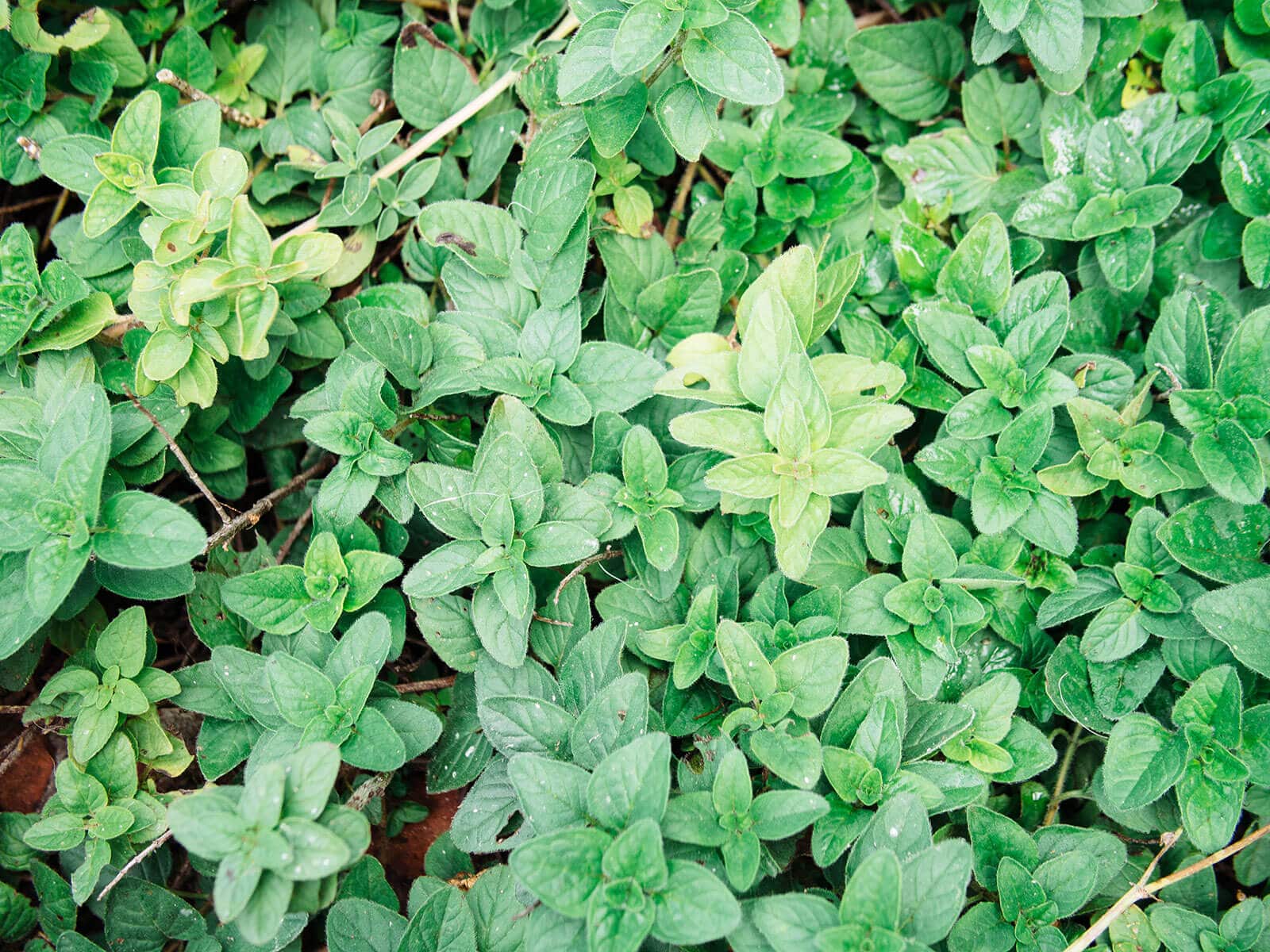
Many people swear by hanging herbs up to dry, but I’ve never found this practical in my kitchen. It’s too small, too sunny, and merely a matter of when—not if—someone bumps into the hanging herbs and scatters crumbs across the floor.
I wish I had the space to hang a line of long-stemmed herbs, bundled up and tied together with rustic twine (and even leave them up for decoration, the way I always see them in the magazines), but that’s not the reality in my busy kitchen that sees way too many bodies and sticky fingers.
What I do is plain and simple, and takes under an hour as opposed to a week: I use my oven!
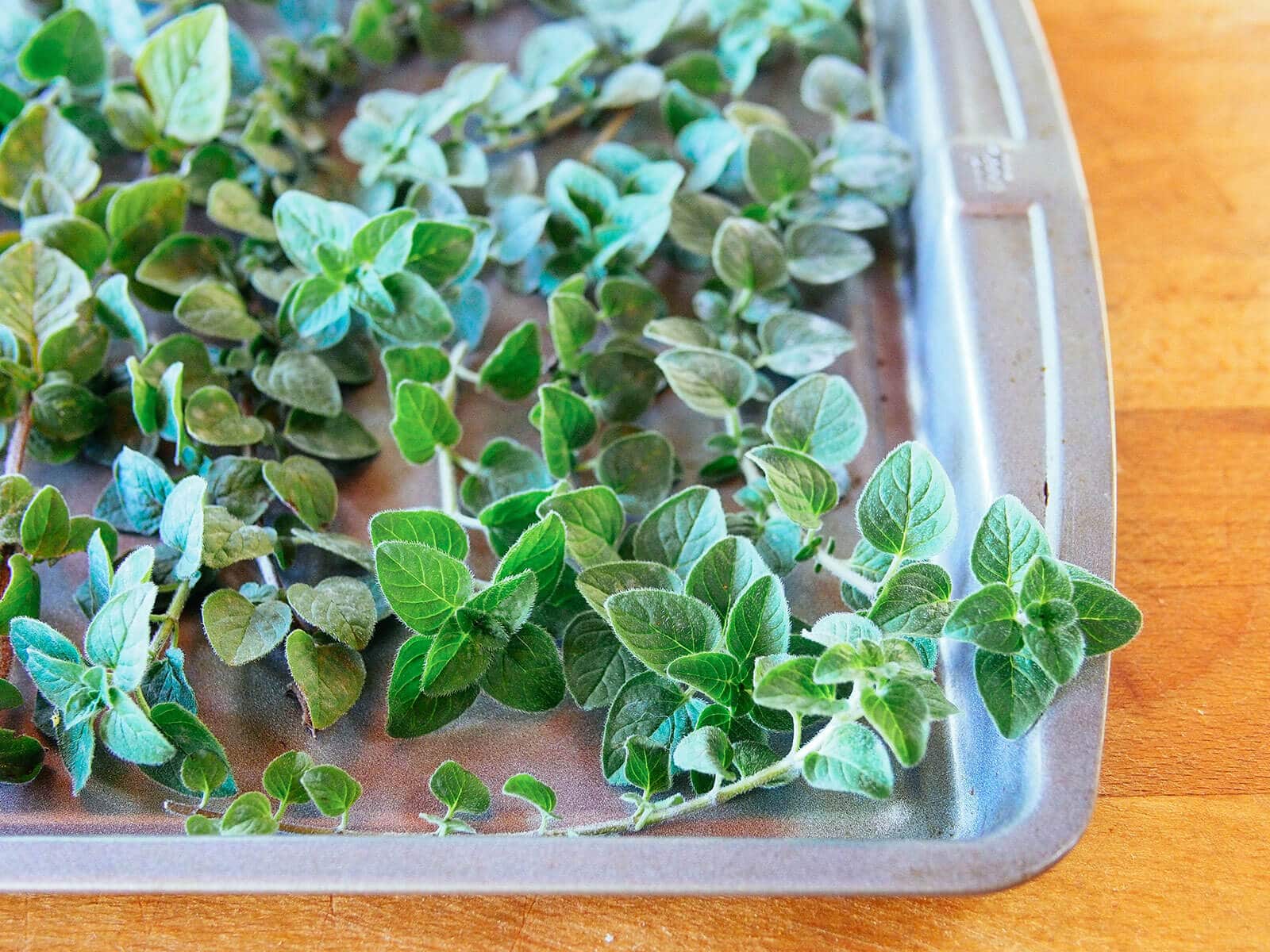
How long does it take to dry fresh oregano?
In the oven, fresh oregano dries within 15 minutes, so you can harvest a large handful of sprigs in the afternoon and use them for dinner that evening.
If you count the time it takes to cool, however, it’s closer to 40 minutes by the time you can handle it and store it.
What temperature should you dry oregano?
Most ovens at home have a low temperature of 200°F which is what I go with in this guide. I’m not using anything fancy—just a conventional gas oven. But, keep in mind that many ovens are off by 5° to 10°, and convection ovens will dry more quickly and evenly than conventional ovens.
If your oven goes down to 170°F, try that first as you’ll significantly reduce the chances of burning the leaves.
Make sure you place the baking sheet on the center rack and position it away from any known hot spots.
What other fresh herbs can you dry in the oven?
The oven-drying method works for oregano as well as for parsley, sage, thyme, mint, and basil (that I’ve tried).
You may have to play around with the time it takes to dry, since it depends on how thick or large the leaves are. Be sure to take notes as the timing for each herb will be specific to your oven.
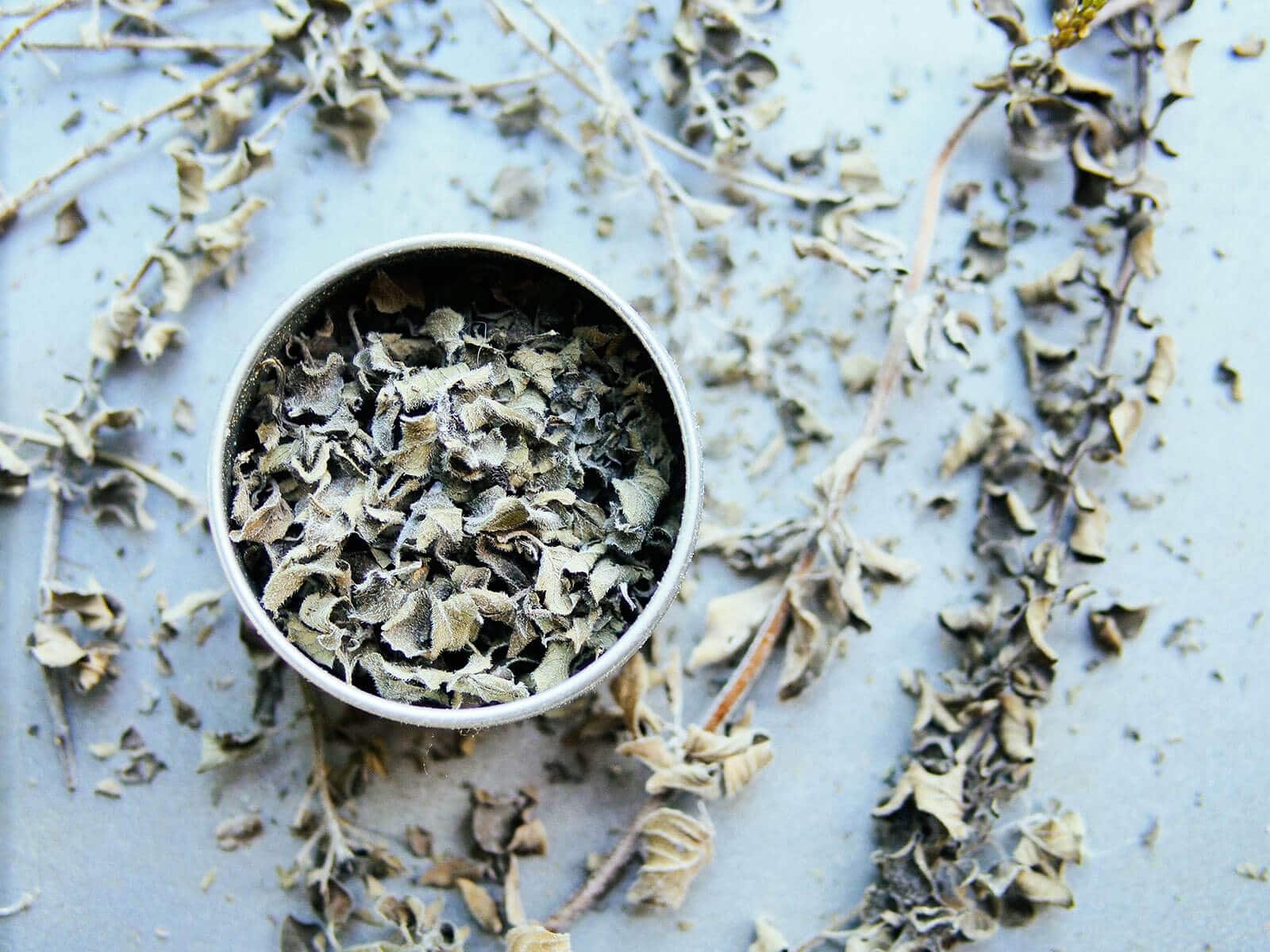
How to dry oregano in under 1 hour
Step 1: Start with very fresh herbs from your garden.
If you grow organically, there’s no need to wash them but if you do, make sure the leaves are very dry (either spun dry in a salad spinner, or thoroughly pressed between towels to remove all the moisture). This ensures the herbs are dried—not steamed—in the oven.
Choose sprigs that have uniformly sized leaves so they all dry at the same time.
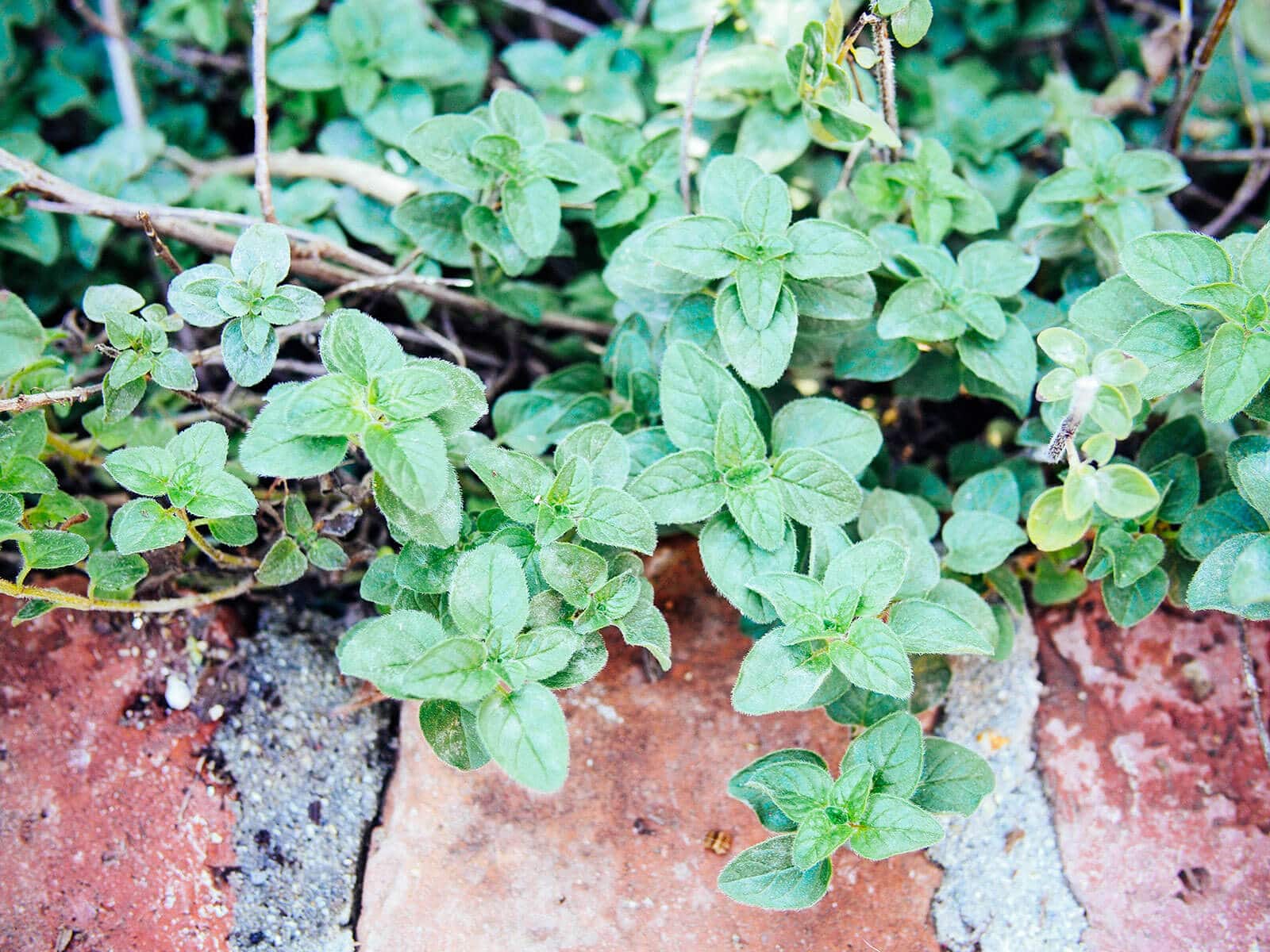
Step 2: Arrange the sprigs of oregano on a baking sheet.
Remove any ratty leaves and spread the herbs out, stems and all, in a single layer across a baking sheet. Try not to overlap them too much as you want air to circulate between the leaves.
If you have a lot of oregano to dry, you might need to do this in two or more batches.
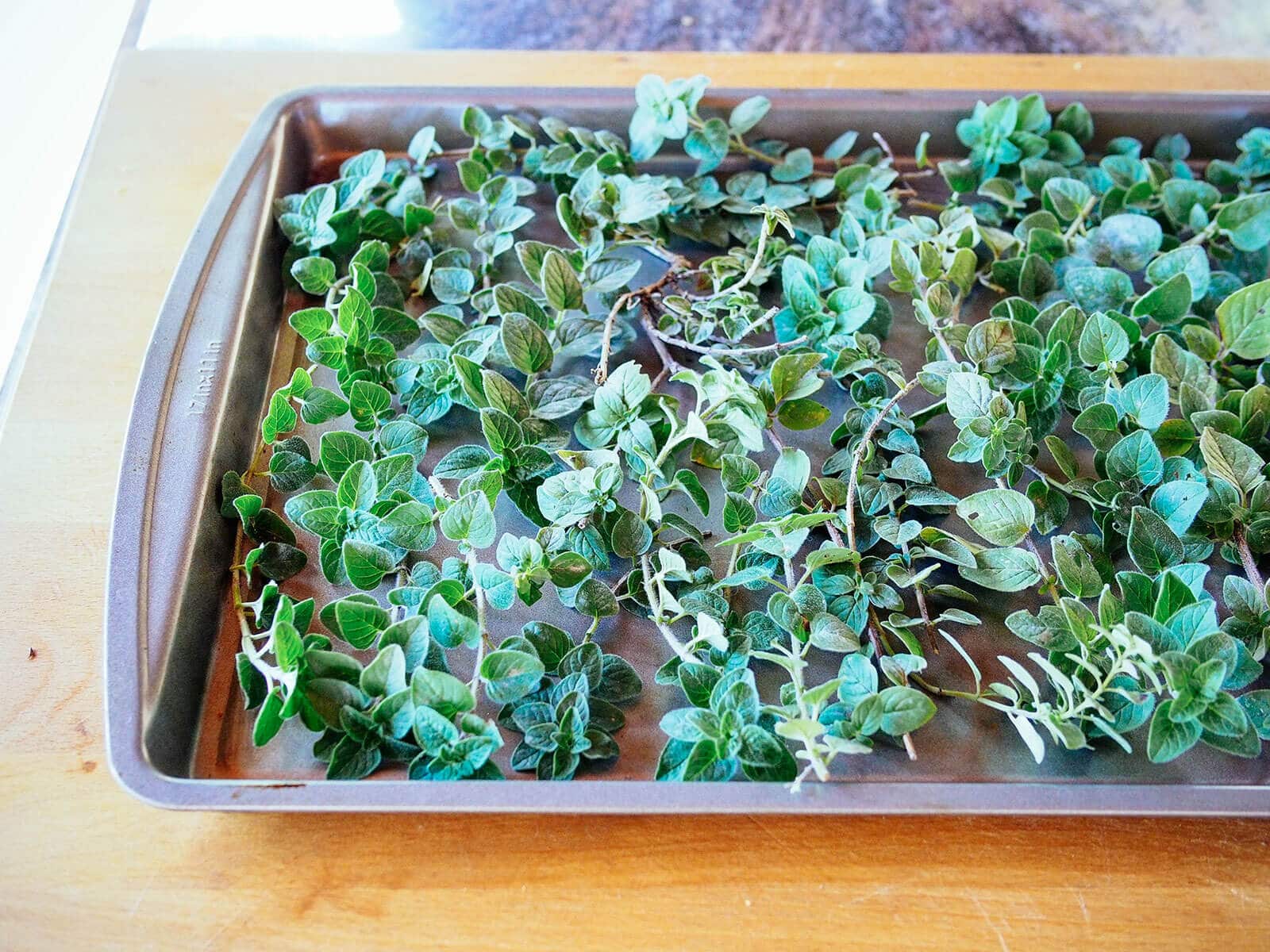
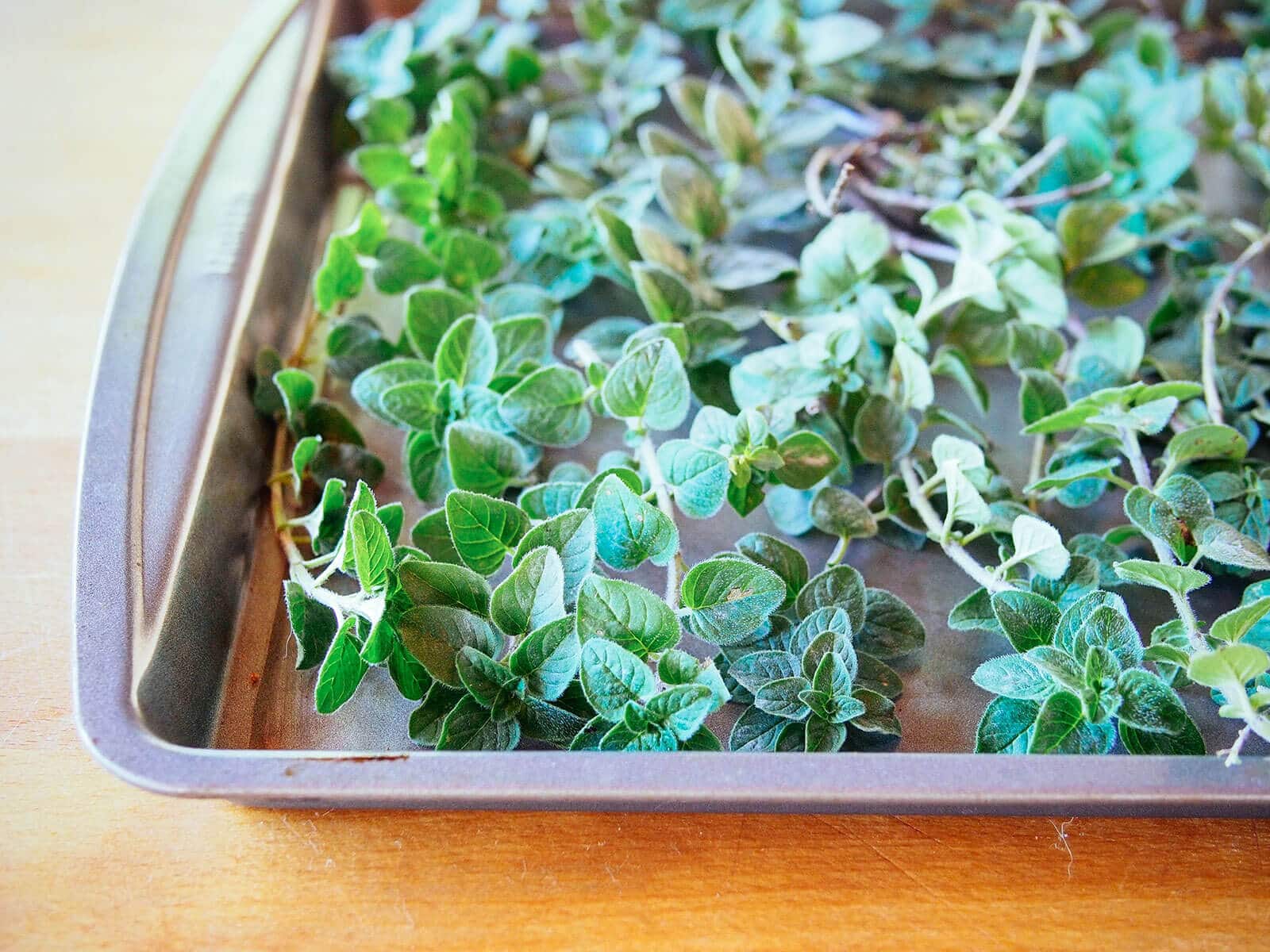
Step 3: Preheat the oven and place the oregano on the center rack to dry.
Set your oven to its lowest temperature setting; mine hovers around 200°F.
Once it’s preheated, place your tray of herbs on the center rack and prop the door open slightly with a wooden utensil to allow some air movement.
Then (important step!) turn the oven off and let the herbs dry inside while the heat slowly dissipates. This method ensures the delicate leaves won’t burn.
They dry within 10 or 15 minutes, but I leave them in the oven until the temperature is completely cool before removing the tray. I simply set it and forget it, then come back to the kitchen in an hour to finish up.
If your oven goes lower (170°F or so), you can likely leave the oven on for the whole duration of the drying process, but you’ll have to be vigilant to ensure you’re not “cooking” the herbs or leaving them in for too long.
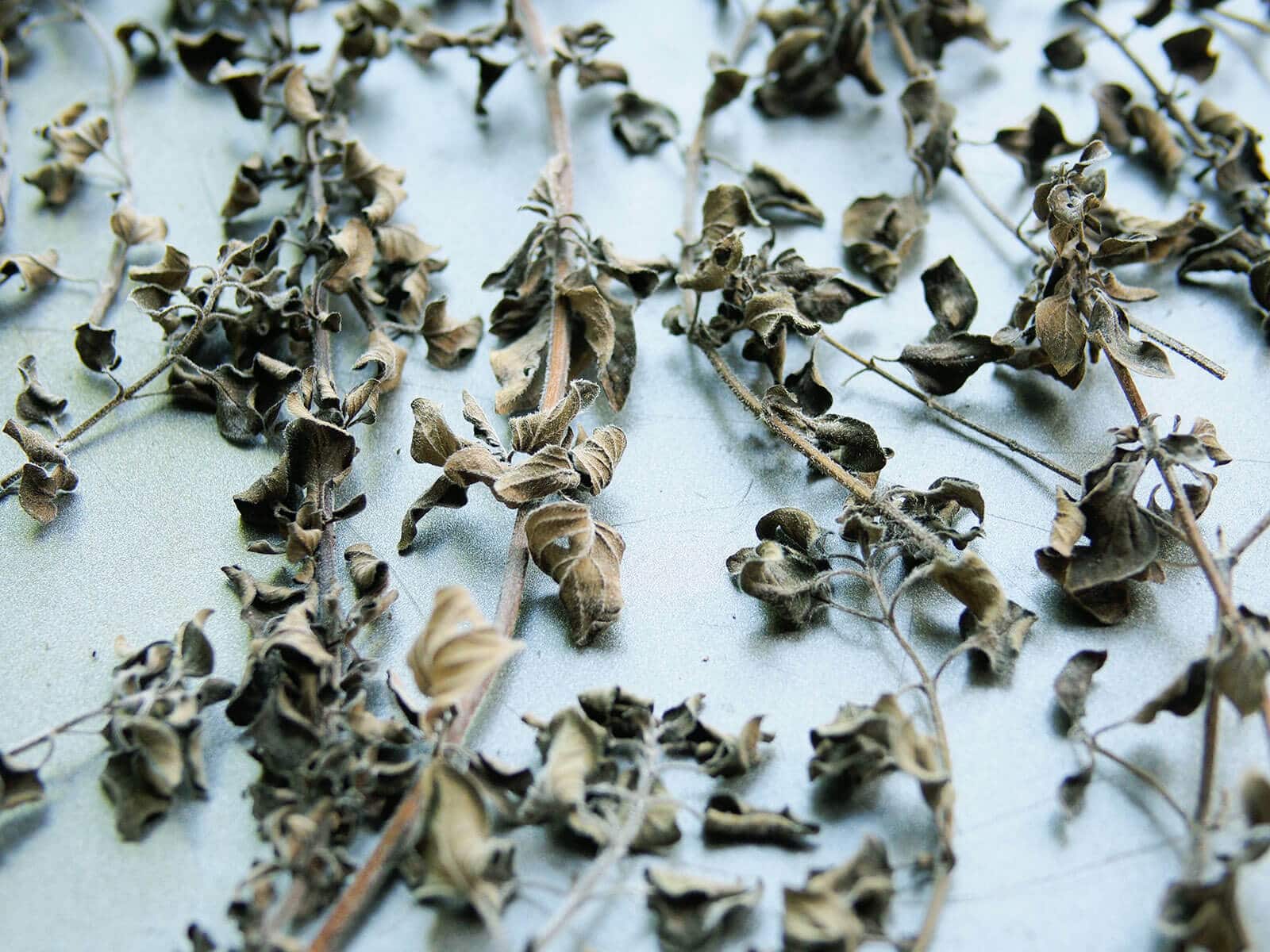
Step 4: Pull the leaves off the stems and store in an airtight container.
Once the oregano is cool enough to touch, pull the leaves off the stems.
Make sure the oregano is completely dry, as any moisture left in the leaves can cause mold. They should crumble easily when you slide your fingers down the stem.
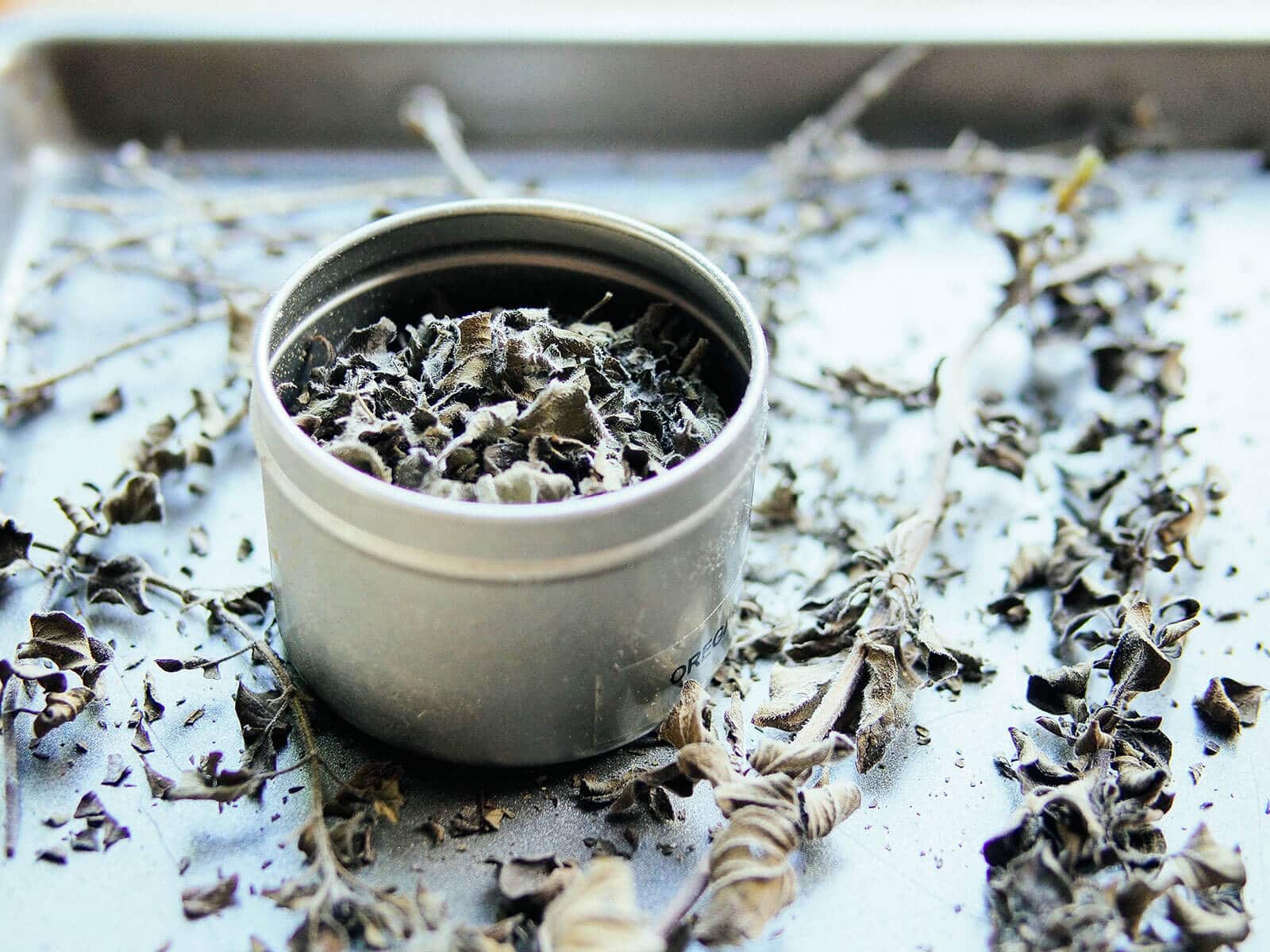
Store the dried oregano in an airtight container for maximum freshness. Under optimal conditions, it should keep for about six months (after that, the flavor and aroma will start to deteriorate and you’ll need to use more of it in your recipes).
Related: Make Your Own Magnetic Spice Rack
I know it sounds like an oxymoron to call dried herbs “fresh,” but I really do love having fresh dried herbs on hand—from my garden—rather than the dried herbs that have been sitting on a store shelf for who knows how long!
Try these other methods of preserving herbs
How to Dry Oregano (and Other Herbs) Fast — Use the Oven!

What's the best way to dry oregano? No, not hung up in neat little bundles, not in a dehydrator... My favorite method is in the oven and it takes less than an hour, so you can pick oregano fresh from your garden in the afternoon, and have it ready for dinner that evening.
Ingredients
- Fresh oregano sprigs
Instructions
Choose sprigs that have uniformly sized leaves so they all dry at the same time.
If you have a lot of oregano to dry, you might need to do this in two or more batches.
Once it's preheated, place your tray of herbs on the center rack and prop the door open slightly with a wooden utensil to allow some air movement.
Then (important step!) turn the oven off and let the herbs dry inside while the heat slowly dissipates. This method ensures the delicate leaves won't burn.
They dry within 10 or 15 minutes, but I leave them in the oven until the temperature is completely cool before removing the tray. I simply set it and forget it, then come back to the kitchen in an hour to finish up.
Make sure the oregano is completely dry, as any moisture left in the leaves can cause mold. They should crumble easily when you slide your fingers down the stem.
Store the dried oregano in an airtight container for maximum freshness. Under optimal conditions, it should keep for about six months (after that, the flavor will start to deteriorate and you'll need to use more of it in your recipes).
Recommended Products
As an Amazon Associate and member of other affiliate programs, I earn from qualifying purchases.
This post updated from an article that originally appeared on October 30, 2013.
View the Web Story on drying oregano and other herbs in the oven.


















Did you use parchment paper to line the baking sheets?
Your recipe is potentially lethal. You don’t mention even once the prospect of releasing carbon monoxide by propping the oven door open. Readers should have a BIG BOLD NOTE mentioning that reason. This is irresponsible and reckless.
As stated in bold type in the instructions, the oven is already off when the door is propped open, and the herbs dry in less than 15 minutes. Once dry, you can remove your herbs and close the oven door. The potential for carbon monoxide to reach lethal levels is quite slim unless you forget to turn your oven off.
Out of interest, do you live in a tent?
Sorry this was ment for bad article reply
I was just introduced to your blog! Going to have to try this with my oregano!
Hi and welcome! Hope it turned out great for you!
After reading through the instructions and comments, I dried my oregano in an over with the lowest temp of 170F for one hour/door closed and then another 1/2 hour propped open with a spoon. Came out perfect. To prep it, I swished in a tub of cold water, carefully shook the excess water off and then put in my salad spinner to get a whole lot more off. Worked great. I have the next bunch in the oven right now! =)
So happy this worked out for you! Enjoy!
I was reading the comment sections, and I think something has to be mentioned. All my herbs are organic, but they still need to be washed. I learned this this year when i made fresh pesto. If you don’t wash them, you letting spores and bacteria come into your food. It’s called bird droppings, ants and pest eggs, that are so small you don’t notice it, also, you have no idea if pesticides used by your neighbors have blown over to your side. Always wash them, it’s so easy to use a paper towel to dry them. After making 8 jars of pesto, I keep them in the freezer, and pull out what I need. I pulled out two jars to slow defrost in the fridge, because I was going to need it the following week, when I pulled both jars out of the fridge the following week, one was bulging at the top, a sure sign of possible botulism. Lesson learned.. wash all veggies.
I’m not sure what you mean by “bulging,” but botulism is quite rare and cannot grow in the cold temperatures of a freezer or refrigerator.
Sounds like you didn’t sterilize your jars.
I honestly wouldn’t really recommend doing this with basil, but if you’ve had a much better outcome than me, I’d love to hear how you handle this particular herb.
My fallout involves the plant ending up really losing much flavor then turning to a plain wet leave smell when barely dry enough. I have best luck drying this herb leaves far spread out on screen for a couple weeks to dry in my attic in hot summers, I’d love to speedup the process though. would you personally have the heat the same, or even find lower temp? Thank you. Have a great weekend!
A few tips that may help: start with dry basil (I never wash mine after harvesting), and use the lowest oven temp (sometimes just called “warm”). Since ovens vary so much with the amount of heat they actually put out, you can try propping the door open wider to get more airflow in there, or use the convection setting to ensure adequate circulation.
Perhaps try preheating the oven WITH the herbs already inside, and remove them as soon as the oven reaches the final temp. You’ll have to experiment with your particular oven… good luck!
That does make sense. Thank you!
What many people don’t realize is that herbs don’t just need to dry, they need to CURE. The enzymes in the plant need to use up the sugars or you get that nasty GREEN taste. Air drying is best.
I am taking my dried leaves off the stems, but am not sure what to do with th flower buds. Are they good to include with the dried leaves, or should I discard them?
Yes, you can absolutely use the flowers! They’re just as edible and have the same flavor as the leaves.
Hello, I have tried the method described herein with lower temp that 200F and have found that leaves do indeed burn (no air movement and too high a starting temp are the reasons). Oven door was ajar with wooden spoon large enough for heat flow. My leaves appear exactly as yours do in your photos above, burned. Oregano should be a panzer gray when dried. This color indicates proper duration to remove water without reaction The burned oregano does not have the desired flavor or smell.
Dried oregano has more of a dull khaki/green color; mine only turns gray as it ages. It comes out of the oven very fragrant. Since all ovens vary, you may need to experiment with the right time and temp to ensure yours is properly dried.
Turn off oven as soon as you put herbs in. Check every half hour or so. May need to turn oven on again for a few minutes.
nice tips. I will try to grow more oregano so I could harvest a lot. I’m dying to have a dried oregano to put on a chicken dish
I am glad to catch idea from your article. It has information I have been searching for a long time. Thanks so much.
Quick-Drying Oregano (and Other Herbs) in the Oven http://t.co/KwIhdOfDtO < TY for RT! @DonnaSMenke @rareseeds @TheLulzDeptxx
RT @theGardenBetty: If you don’t overwinter your herbs, dry them for a steady supply: Quick-Drying Oregano (and Other Herbs) in the Oven ht…
RT @theGardenBetty: If you don’t overwinter your herbs, dry them for a steady supply: Quick-Drying Oregano (and Other Herbs) in the Oven ht…
The Horticult liked this on Facebook.
If you don’t overwinter your herbs, dry them for a steady supply: Quick-Drying Oregano (and Other Herbs) in the Oven http://t.co/N3JBb2ivtG
RT @TuffGuardHose: “Quick-Drying Oregano (And Other Herbs) In The Oven” http://t.co/MlOfERhML4 #herbchat
RT @TuffGuardHose: “Quick-Drying Oregano (And Other Herbs) In The Oven” http://t.co/MlOfERhML4 #herbchat
RT @theGardenBetty: Fire up the oven for a few minutes, then let the herbs dry slowly. Quick-Drying Oregano (and Other Herbs) in the Oven h…
Fire up the oven for a few minutes, then let the herbs dry slowly. Quick-Drying Oregano (and Other Herbs) in the Oven http://t.co/KwIhdOfDtO
RT @TuffGuardHose: “Quick-Drying Oregano (And Other Herbs) In The Oven” http://t.co/MlOfERhML4 #herbchat
RT @TuffGuardHose: “Quick-Drying Oregano (And Other Herbs) In The Oven” http://t.co/MlOfERhML4 #herbchat
RT @TuffGuardHose: “Quick-Drying Oregano (And Other Herbs) In The Oven” http://t.co/MlOfERhML4 #herbchat
“Quick-Drying Oregano (And Other Herbs) In The Oven” http://t.co/MlOfERhML4 #herbchat
Drying your own fresh herbs at home is quick and easy. Quick-Drying Oregano (and Other Herbs) in the Oven http://t.co/Aour15sMVb #recipe
Really thank you with the information you have provided, it rather interesting. I tried that and found very good results. Continue to share the same information offline, I’m looking forward to.
The oven-drying method works for thyme, mint, sage too: Quick-Drying Oregano (and Other Herbs) in the Oven http://t.co/i7Sz2Ls6L1 #recipe
If you grow your own at home, never buy dried herbs again: Quick-Drying Oregano (and Other Herbs) in the Oven http://t.co/CcQbjtGZ44 #recipe
Sounds easier than when I used my dehydrator! RT @theGardenBetty Quick-Drying Oregano (and Other Herbs) in the Oven http://t.co/YJ0ApIZA2q
Thanks for the tip. I’ve done microwave drying before but not oven. I’m going to try this out since I’m in the northeast and frost is coming soon.
Diana Heffernan-Schrader liked this on Facebook.
Rolo Solis liked this on Facebook.
Yeah! I’m in the same boat, what a coincidence!
Very good timing and so much easier than the hanging method, thanks!
RT @BG_garden: Quick-Drying Oregano (and Other Herbs) in the Oven:
Living in such a mild climate means I’m lucky to have fre… http://t.c…
Your timing is stellar! I kid you not. I was just this moment, looking at my huge sage plant and wondering what the best way to preserve its leaves for winter cooking would be. Thanks again, so much Linda!
Kelly Dugan Guerin liked this on Facebook.
Savannah Zendejas liked this on Facebook.
RT @BG_garden: Quick-Drying Oregano (and Other Herbs) in the Oven:
Living in such a mild climate means I’m lucky to have fre… http://t.c…
Quick-Drying Oregano (and Other Herbs) in the Oven:
Living in such a mild climate means I’m lucky to have fre… http://t.co/FSTE5SahfM
Blogged on Garden Betty: Quick-Drying Oregano (and Other Herbs) in the Oven http://t.co/9dHW9uoKbT